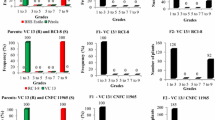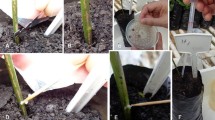Abstract
Screening of 51 promising safflower germplasm lines in Fusarium wilt-infested plots resulted in identification of highly wilt-resistant selections viz., 86-93-36A, 237550, VI-92-4-2 and II-13-2A, with some moderate resistance in HUS-305. Progenies from crosses made using these resistant lines were tested for their reaction to wilt. F1 progenies from 86-93-36A × 237550 and 86-93-36A × II-13-2A recorded zero wilt incidence, while 237550 × 86-93-36A was highly resistant to the Rajendranagar geographical isolate. The reaction for the three progenies showed stability for wilt resistance with no segregation until the F7 generation. Geographical isolates of Fusarium oxysporum f. sp. carthami (Foc) were collected from different safflower growing regions and tested for their pathogenic variability on six host differentials under glasshouse conditions. Based on the reaction of the differentials, the Foc isolates were grouped into four biotypes. The three resistant progenies were tested for their reaction to the four biotypes. The progeny of cross 86-93-36A × 237550 showed an immune reaction to all the biotypes, except for a highly resistant reaction to biotype 3. The progenies of the two other crosses (86-93-36A × II-13-2A and 237550 × 86-93-36A) exhibited immune reactions to biotypes 2, 3 and 1, 3, respectively, and were highly to moderately resistant to biotypes 1, 4 and 2, 4, respectively.
Similar content being viewed by others
References
Bockelman HE (1974) The inheritance of resistance to Fusarium wilt in cultivated safflower (Carthamus tinctorius L.). Dissertation Abstracts International-B 34: 1727
Chakrabarti DK (1979) Pathogenic and cultural variation of the safflower wilt-organism Fusarium oxysporum f. sp. carthami. Proceedings of Indian National Science Academy-B 45: 383-386
Directorate of Oilseeds Research (DOR) (1995) Package of Practices for Increasing Production of Safflower. Directorate of Oilseeds Research, Rajendranagar, Hyderabad 500030, 26 pp
Kalpana Sastry R (1996) Symptoms of wilt disease-clues for use in resistance breeding. In: Hegde DM, Raghavaiah CV and Pati D (eds) Proceedings of Training Programme on Breeding Approaches for Improving Productivity of Safflower and Group Meeting on Heterosis Breeding in Safflower (pp 25-32) Directorate of Oilseeds Research, Rajendranagar, Hyderabad 500030
Kalpana Sastry R and Chattopadhyay C (1997) Viable approaches for effective management of wilt in safflower. In: Corleto A, Mundel HH, Kalpana Sastry R, Riveland N, Tanaka DL, Fernandez-Martinez J, Zhang LP, Esendal E and Hill AB (eds) Proceedings of IVth International Safflower Conference, 2-7 June 1997 (pp 295-298) Adriatica Editrice, Bari, Italy
Kalpana Sastry R and Chattopadhyay C (1999) Effect of soil solarization on Fusarium oxysporum f. sp. carthami population in endemic soils. Indian Phytopathology 52: 51-55
Kalpana Sastry R and Ramachandram M (1992) Differential genotypic response to progressive development of wilts in safflower. Journal of Oilseeds Research 9: 297-305
Kalpana Sastry R, Rego TJ, Nageswara Rao V and Kiresur V (1994) Economic optimum of feasible cropping systems for management of wilts in safflower. In: Prasad MVR, Kalpana Sastry R, Raghaivaiah CV and Damodaram T (eds) Sustainability in Oilseeds (pp 413-416) Indian Society of Oilseeds Research, Hyderabad 500030
Klisiewicz JM (1980) Safflower germplasm resistant to Fusarium wilt. Plant Disease 64: 876-877
Klisiewicz JM and Houston BR(1962) Fusarium wilt of safflower. Plant Disease Reporter 46: 748-749
Luchina NN (1979) Methods of producing flax forms resistant to Fusarium wilt. Selektsiya-i-Semenovodstvo 5: 24-25
Mayee CD and Datar VV(1986) Phytometry,Technical Bulletin I, Marathwada Agricultural University, Parbhani, Maharashtra
Singh Vrijendra, Galande MK, Deshpande MB and Nimbkar N (2001) Inheritance of wilt (Fusarium oxysporum f. sp. carthami) resistance in safflower. In: Bergman JW, Mundel HH, Jensen JL, Flynn CR, Grings EE, Tanaka DL, Riveland NR, Johnson RC and Hill AB (eds) Proceedings of Vth International Safflower Conference, 23-27 July 2001 (pp 127-131) Williston, North Dakota and Sidney, Montana, USA
Zayed MA, Yehia AH, El-Sabaey MA and Gowily AM (1980) Studies on the host-parasite relationships of safflower root rot disease caused by Fusarium oxysporum Schlecht. Egypt. Journal of Phytopathology 12: 63-70
Author information
Authors and Affiliations
Corresponding author
Rights and permissions
About this article
Cite this article
Kalpana Sastry, R., Chattopadhyay, C. Development of Fusarium Wilt-resistant Genotypes in Safflower (Carthamus tinctorius). European Journal of Plant Pathology 109, 147–151 (2003). https://doi.org/10.1023/A:1022502618887
Issue Date:
DOI: https://doi.org/10.1023/A:1022502618887




